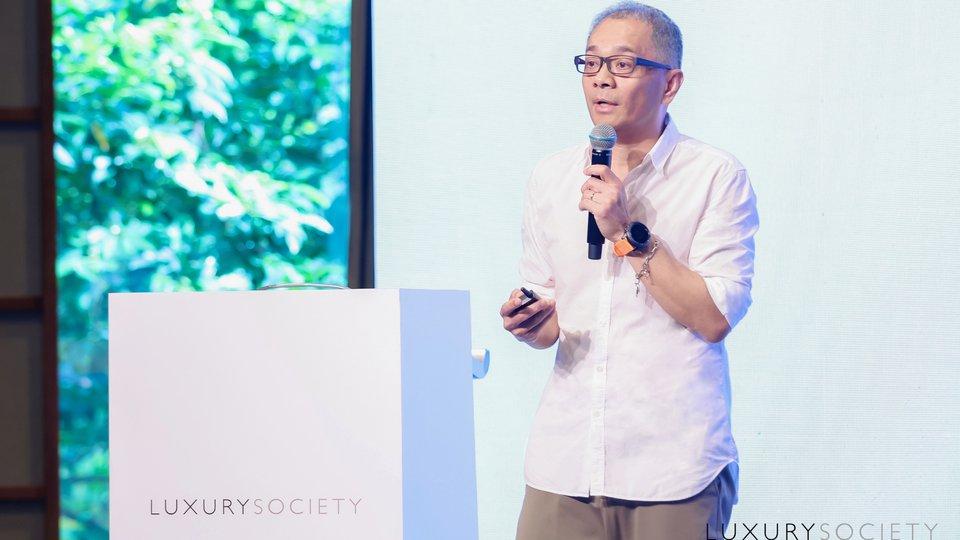
The fourth annual Luxury Society Keynote in Shanghai focused on new retail models for a digital age.
Held at the Four Seasons Hotel Shanghai on November 28, the Luxury Society Keynote included presentations from Chinese tech titans – Alibaba and Tencent – as well as speakers with unique insights into the luxury and digital space in China. Over 140 representatives from top luxury brands including Bottega Veneta, Montblanc, Swarovski, Vacheron Constantin and Shangri-La Hotels & Resorts were in attendance, and spent time networking and sharing experiences at the cocktail reception after.

David Sadigh, the Publisher of Luxury Society as well as Founder and CEO of DLG (Digital Luxury Group) giving the opening address.
China is, undisputedly, the largest and most important market for luxury consumption in the world, and boasts the most developed e-commerce ecosystem globally.
What is New Retail?
The term “new retail” has become a slogan for tech giants, particularly Chinese e-commerce companies looking to combine online and offline shopping experiences. As the biggest e-commerce players in the country continue to grow at breakneck speed, they are increasingly looking to brick and mortar stores as the new frontier in the race to win the hearts, and wallets, of Chinese consumers. These e-commerce companies have been leveraging their technological acumen to create unique, seamless in-store shopping experiences with a futuristic twist, be it augmented reality technology, smart stores with facial recognition payments, or automated pop-up stores.
With the major e-commerce giants consolidating both online and offline spheres in China, many foreign luxury brands looking to enter the country, or increase their presence both online and offline, choose to partner with one of the e-commerce players, such as Alibaba’s B2C platform, Tmall. Alibaba have made “new retail” one of the company’s core strategies, and successfully integrated the model into the biggest shopping festival on earth, Single’s Day, with online and offline sales activity.

Qian Yi, Global Business Development and Key Account Director of Tmall Global
“This year, more than 100,000 stores participated in 11.11. Many of them were our brand partners because they see how we can help them to digitalize, not just online, but also offline. I’m sure we are still in the early stage of the new retail experience, but there are many more that we will discover and find with our partners,” said speaker Qian Yi, global business development and key account director for Tmall Global.
Whether or not brands choose to partner with one of the big e-commerce players, in China they must embrace an online retail strategy. China is the world’s largest e-commerce market, with sales hitting $1.53 trillion this year. This online segment, however, is highly complex, with a glut of online retailers and aggregators. It is of paramount importance that brands pick the correct platform and are able to target the right consumers.

Pablo Mauron, Partner and Managing Director China of DLG (Digital Luxury Group)
“We really focus on what we see as marketers and what we are going to present to the consumers. We tend to forget about all of the foundations that are required to operate an e-commerce platform; IT, warehousing, fulfilment, delivery. You’ve got a lot of different elements that need to be addressed before figuring out if your product is going to go on a WeChat Store or if it is going to go on your website,” said Pablo Mauron, partner and managing director, China of DLG (Digital Luxury Group).
E-commerce in China
Although new retail was the buzzword of the luxury event, the importance of e-commerce in the vast country cannot be overlooked. There is an ever-growing demand from Chinese consumers in lower tier cities, who have an increasing level of disposable income and growing awareness of foreign, luxury brands, but who are underserved by physical stores. As education levels rise, and outbound tourism becomes more popular, supply has fallen out-of-step with demand, with many smaller cities underpenetrated by luxury brands. Instead, these consumers rely on online platforms to make purchases.

Larry Lu, Vice General Manager at WeChat Pay Operations, Tencent
“In China, only 50 percent of sales is actually from people living in the big cities of China. Tier two, where luxury brands don’t usually have brick and mortar stores, is one of the reasons why e-commerce in China is so important,” said Larry Lu, vice general manager at Tencent’s WeChat Pay.










